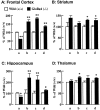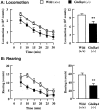Lower sensitivity to stress and altered monoaminergic neuronal function in mice lacking the NMDA receptor epsilon 4 subunit
- PMID: 11896172
- PMCID: PMC6758257
- DOI: 10.1523/JNEUROSCI.22-06-02335.2002
Lower sensitivity to stress and altered monoaminergic neuronal function in mice lacking the NMDA receptor epsilon 4 subunit
Abstract
NMDA receptors, an ionotropic subtype of glutamate receptors (GluRs), play an important role in excitatory neurotransmission, synaptic plasticity, and brain development. They are composed of the GluRzeta subunit (NR1) combined with any one of four GluRepsilon subunits (GluRepsilon1-GluRepsilon4; NR2A-NR2D). Although the GluRzeta subunit exists in the majority of the CNS throughout all stages of development, the GluRepsilon subunits are expressed in distinct temporal and spatial patterns. In the present study, we investigated neuronal functions in mice lacking the embryonic GluRepsilon4 subunit. GluRepsilon4 mutant mice exhibited reductions of [(3)H]MK-801 [(+)-5-methyl-10,11-dihydro-5H-dibenzo [a,d] cyclohepten-5,10-imine maleate] binding and (45)Ca(2+) uptake through the NMDA receptors. The expression of GluRzeta subunit protein, but not GluRepsilon1 and GluRepsilon2 subunit proteins, was reduced in the frontal cortex and striatum of the mutant mice. A postmortem examination in GluRepsilon4 mutant mice revealed that tissue contents of norepinephrine, dopamine, serotonin, and their metabolites were reduced in the hippocampus and that dopamine, as well as serotonin, metabolism was upregulated in the frontal cortex, striatum, hippocampus, and thalamus. To clarify the phenotypical influences of the alteration in neuronal functions, performances in various behavioral tests were examined. GluRepsilon4 mutant mice showed reduced spontaneous locomotor activity in a novel environment and less sensitivity to stress induced by the elevated plus-maze, light-dark box, and forced swimming tests. These findings suggest that GluRepsilon4 mutant mice have dysfunctional NMDA receptors and altered emotional behavior probably caused by changes in monoaminergic neuronal activities in adulthood.
Figures






Similar articles
-
Hyperfunction of dopaminergic and serotonergic neuronal systems in mice lacking the NMDA receptor epsilon1 subunit.J Neurosci. 2001 Jan 15;21(2):750-7. doi: 10.1523/JNEUROSCI.21-02-00750.2001. J Neurosci. 2001. PMID: 11160454 Free PMC article.
-
Behavioural adaptations to addictive drugs in mice lacking the NMDA receptor epsilon1 subunit.Eur J Neurosci. 2004 Jan;19(1):151-8. doi: 10.1111/j.1460-9568.2004.03086.x. Eur J Neurosci. 2004. PMID: 14750973
-
Nucleus-specific expression of ionotropic glutamate receptor subunit mRNAs and binding sites in primate thalamus.Brain Res Mol Brain Res. 2000 Jun 23;79(1-2):1-17. doi: 10.1016/s0169-328x(00)00072-3. Brain Res Mol Brain Res. 2000. PMID: 10925139
-
[Analysis of neuronal functions in mice lacking the NMDA receptor epsilon 1 subunit].Nihon Yakurigaku Zasshi. 2002 Jun;119(6):327-35. doi: 10.1254/fpj.119.327. Nihon Yakurigaku Zasshi. 2002. PMID: 12089904 Review. Japanese.
-
Hippocampal NMDA receptors and anxiety: at the interface between cognition and emotion.Eur J Pharmacol. 2010 Jan 10;626(1):49-56. doi: 10.1016/j.ejphar.2009.10.014. Epub 2009 Oct 15. Eur J Pharmacol. 2010. PMID: 19836379 Free PMC article. Review.
Cited by
-
GluN2D-containing NMDA receptors-mediate synaptic currents in hippocampal interneurons and pyramidal cells in juvenile mice.Front Cell Neurosci. 2015 Mar 25;9:95. doi: 10.3389/fncel.2015.00095. eCollection 2015. Front Cell Neurosci. 2015. PMID: 25859181 Free PMC article.
-
Involvement of the N-methyl-D-aspartate receptor GluN2D subunit in phencyclidine-induced motor impairment, gene expression, and increased Fos immunoreactivity.Mol Brain. 2013 Dec 16;6:56. doi: 10.1186/1756-6606-6-56. Mol Brain. 2013. PMID: 24330819 Free PMC article.
-
Alcohol and NMDA receptor: current research and future direction.Front Mol Neurosci. 2013 May 28;6:14. doi: 10.3389/fnmol.2013.00014. eCollection 2013. Front Mol Neurosci. 2013. PMID: 23754976 Free PMC article.
-
Altered Synaptic and Extrasynaptic NMDA Receptor Properties in Substantia Nigra Dopaminergic Neurons From Mice Lacking the GluN2D Subunit.Front Cell Neurosci. 2018 Oct 11;12:354. doi: 10.3389/fncel.2018.00354. eCollection 2018. Front Cell Neurosci. 2018. PMID: 30364232 Free PMC article.
-
Stress-restress evokes sustained iNOS activity and altered GABA levels and NMDA receptors in rat hippocampus.Psychopharmacology (Berl). 2004 Oct;175(4):494-502. doi: 10.1007/s00213-004-1836-4. Psychopharmacology (Berl). 2004. PMID: 15138761
References
-
- Chaouloff F, Durand M, Mormede P. Anxiety- and activity-related effects of diazepam and chlordiazepoxide in the rat light/dark and dark/light tests. Behav Brain Res. 1997;85:27–35. - PubMed
-
- Contestabile A. Roles of NMDA receptor activity and nitric oxide production in brain development. Brain Res Rev. 2000;32:476–509. - PubMed
-
- Dalvi A, Rodgers RJ. GABAergic influences on plus-maze behaviour in mice. Psychopharmacology. 1996;128:380–397. - PubMed
-
- Forrest D, Yuzaki M, Soares HD, Hg L, Luk DC, Sheng M, Stewart CL, Morgan JI, Connor JA, Curran T. Targeted disruption of NMDA receptor 1 gene abolishes NMDA response and results in neonatal death. Neuron. 1994;13:325–338. - PubMed
Publication types
MeSH terms
Substances
LinkOut - more resources
Full Text Sources
Molecular Biology Databases
